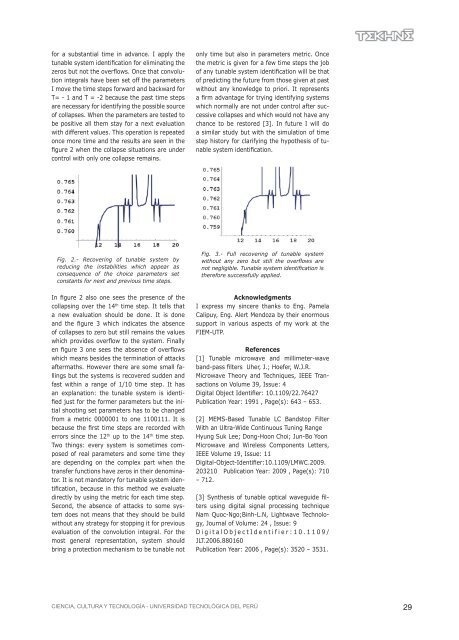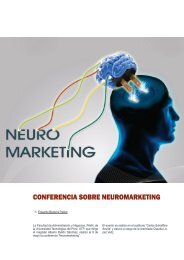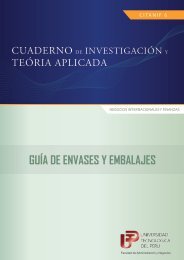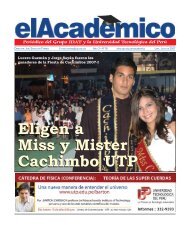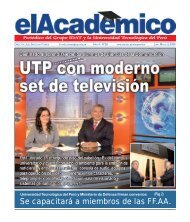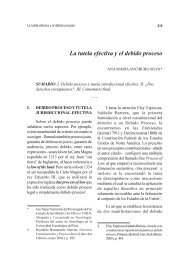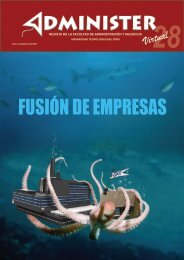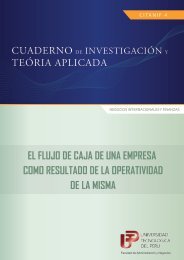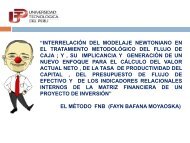Descargar - UTP
Descargar - UTP
Descargar - UTP
Create successful ePaper yourself
Turn your PDF publications into a flip-book with our unique Google optimized e-Paper software.
for a substantial time in advance. I apply the<br />
tunable system identification for eliminating the<br />
zeros but not the overflows. Once that convolution<br />
integrals have been set off the parameters<br />
I move the time steps forward and backward for<br />
T= - 1 and T = -2 because the past time steps<br />
are necessary for identifying the possible source<br />
of collapses. When the parameters are tested to<br />
be positive all them stay for a next evaluation<br />
with different values. This operation is repeated<br />
once more time and the results are seen in the<br />
figure 2 when the collapse situations are under<br />
control with only one collapse remains.<br />
Fig. 2.- Recovering of tunable system by<br />
reducing the instabilities which appear as<br />
consequence of the choice parameters set<br />
constants for next and previous time steps.<br />
In figure 2 also one sees the presence of the<br />
collapsing over the 14 th time step. It tells that<br />
a new evaluation should be done. It is done<br />
and the figure 3 which indicates the absence<br />
of collapses to zero but still remains the values<br />
which provides overflow to the system. Finally<br />
en figure 3 one sees the absence of overflows<br />
which means besides the termination of attacks<br />
aftermaths. However there are some small fallings<br />
but the systems is recovered sudden and<br />
fast within a range of 1/10 time step. It has<br />
an explanation: the tunable system is identified<br />
just for the former parameters but the initial<br />
shooting set parameters has to be changed<br />
from a metric 0000001 to one 1100111. It is<br />
because the first time steps are recorded with<br />
errors since the 12 th up to the 14 th time step.<br />
Two things: every system is sometimes composed<br />
of real parameters and some time they<br />
are depending on the complex part when the<br />
transfer functions have zeros in their denominator.<br />
It is not mandatory for tunable system identification,<br />
because in this method we evaluate<br />
directly by using the metric for each time step.<br />
Second, the absence of attacks to some system<br />
does not means that they should be build<br />
without any strategy for stopping it for previous<br />
evaluation of the convolution integral. For the<br />
most general representation, system should<br />
bring a protection mechanism to be tunable not<br />
CIENCIA, CULTURA Y TECNOLOGÍA - UNIVERSIDAD TECNOLÓGICA DEL PERÚ<br />
only time but also in parameters metric. Once<br />
the metric is given for a few time steps the job<br />
of any tunable system identification will be that<br />
of predicting the future from those given at past<br />
without any knowledge to priori. It represents<br />
a firm advantage for trying identifying systems<br />
which normally are not under control after successive<br />
collapses and which would not have any<br />
chance to be restored [3]. In future I will do<br />
a similar study but with the simulation of time<br />
step history for clarifying the hypothesis of tunable<br />
system identification.<br />
Fig. 3.- Full recovering of tunable system<br />
without any zero but still the overflows are<br />
not negligible. Tunable system identification is<br />
therefore successfully applied.<br />
Acknowledgments<br />
I express my sincere thanks to Eng. Pamela<br />
Calipuy, Eng. Alert Mendoza by their enormous<br />
support in various aspects of my work at the<br />
FIEM-<strong>UTP</strong>.<br />
References<br />
[1] Tunable microwave and millimeter-wave<br />
band-pass filters Uher, J.; Hoefer, W.J.R.<br />
Microwave Theory and Techniques, IEEE Transactions<br />
on Volume 39, Issue: 4<br />
Digital Object Identifier: 10.1109/22.76427<br />
Publication Year: 1991 , Page(s): 643 – 653.<br />
[2] MEMS-Based Tunable LC Bandstop Filter<br />
With an Ultra-Wide Continuous Tuning Range<br />
Hyung Suk Lee; Dong-Hoon Choi; Jun-Bo Yoon<br />
Microwave and Wireless Components Letters,<br />
IEEE Volume 19, Issue: 11<br />
Digital-Object-Identifier:10.1109/LMWC.2009.<br />
203210 Publication Year: 2009 , Page(s): 710<br />
– 712.<br />
[3] Synthesis of tunable optical waveguide filters<br />
using digital signal processing technique<br />
Nam Quoc-Ngo;Binh-L.N, Lightwave Technology,<br />
Journal of Volume: 24 , Issue: 9<br />
DigitalObjectIdentifier:10.1109/<br />
JLT.2006.880160<br />
Publication Year: 2006 , Page(s): 3520 – 3531.<br />
29


